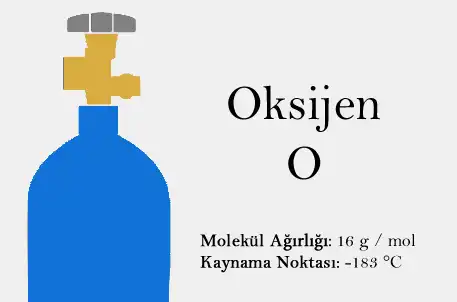Oxygen gas (chemical formula O₂) is a colorless, odorless, and tasteless gas composed of two oxygen atoms. Critical to life on Earth, oxygen is found in air at about 21% by volume and plays a role in many biological and chemical processes. It is a fundamental component, especially in the respiration of living things and in combustion processes.
Properties of Oxygen Gas:
- Chemical Structure:
Oxygen gas is a molecule formed by two oxygen atoms forming a covalent bond. This molecular structure allows oxyge n to exist in a stable form in nature.
n to exist in a stable form in nature.
- Colorless, Odorless and Tasteless:
Oxygen gas is colorless, odorless and tasteless. It is normally found in gaseous form, but can be liquefied at low temperatures.
- A Reactive Element:
Oxygen is a highly reactive gas. It easily combines with many elements and forms oxide compounds. Combustion, rusting and other oxidation reactions occur thanks to this reactive property of oxygen.
- Paramagnetic Property:
Oxygen gas is a paramagnetic gas that is weakly attracted to a magnetic field. Thanks to this property, it can be easily detected in laboratory environments.
Areas of Use of Oxygen Gas:
- Respiration and Life: Oxygen is necessary for the respiratory process of almost all living things, including humans. Respiration allows cells to produce energy using oxygen.
- Medical Use: Oxygen is used for various medical conditions. Oxygen therapy is applied to patients with respiratory difficulties. In addition, pure oxygen support is provided in emergency situations or intensive care units.
- Combustion and Industrial Processes: Oxygen is necessary for combustion events to occur. Therefore, pure oxygen is used in many industrial processes (e.g. steel production, glass making and welding processes). The ability of oxygen to accelerate the combustion process allows higher temperatures to be achieved.
- Welding and Cutting Processes: Oxygen is widely used, especially in the metalworking sector. In processes such as oxy-acetylene welding, a high-temperature flame is created using pure oxygen, and this flame is used for metal cutting and welding.
- Water Treatment: Oxygen is used in water treatment plants for microorganisms to break down organic substances. Aerobic bacteria use oxygen to break down waste, and this process helps clean water.
- Aerospace Industry: Oxygen is used in liquid form as rocket fuel. Liquid oxygen burns with liquid hydrogen to provide great thrust. This allows spacecraft to leave the atmosphere.
- Chemical Industry: Oxygen is used to enable many chemical reactions to occur. Oxygen plays an important role, especially in oxidation reactions and various chemical production processes.
Advantages of Oxygen Gas:
- Vital for Living Things: Oxygen is one of the most basic elements necessary for living things to survive. Oxygen is necessary for the energy production and metabolic activities of cells.
- Clean Combustion: Oxygen ensures that fuels burn more efficiently and cleanly. Oxygen-enriched combustion processes produce less harmful waste and emissions.
- Versatile Areas of Use: Oxygen can be used in many different areas from medicine to industry. This makes it a critical gas for both health and technological processes.
Oxygen gas is of vital importance in biological, industrial and chemical processes. This gas, which is vital for living things, is also a critical component for energy production and industrial processes.
 English
English
 Türkçe
Türkçe


